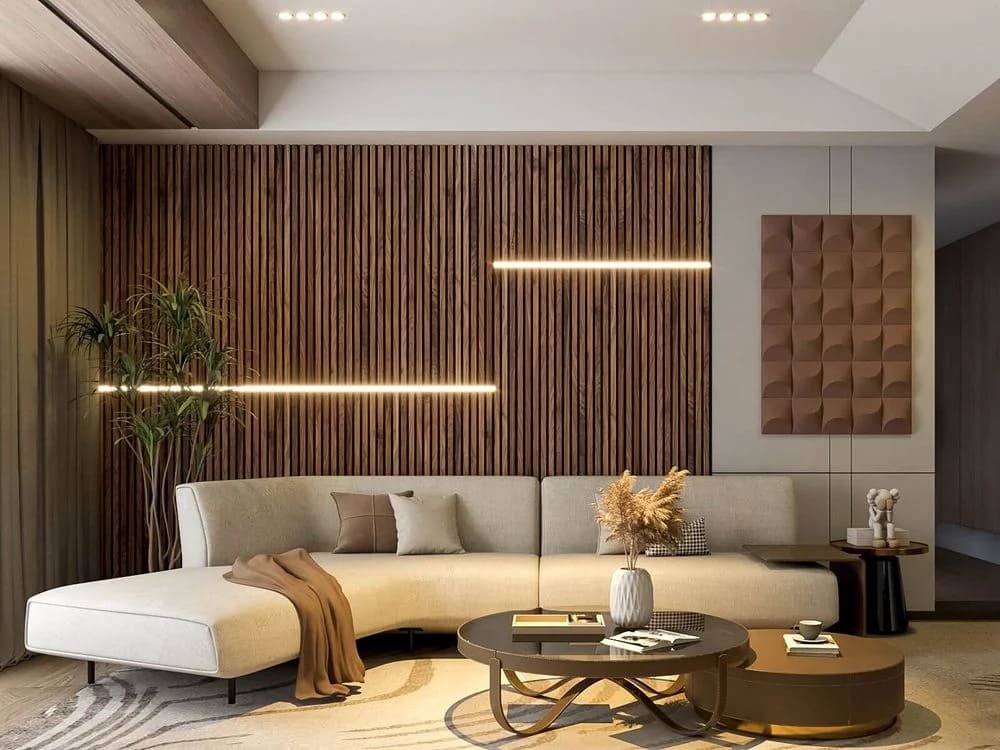12V or 24V LED Strip Lights: What’s The Difference And Why It Matters

LED strip lights are a game-changer in home design, offering sleek, flexible lighting that instantly elevates any space. But before you install, there’s one key decision to make: 12V or 24V LED trip?
It might sound technical, but the voltage you choose affects everything from brightness and efficiency to how far your lighting can run. This guide breaks down the differences between 12V and 24V LED strips in simple terms, so you can light your space with confidence.
Planning to install them with a modern wood accent wall? Woody Walls offers LED-ready wood slat panels and channels that work seamlessly with both options, making stylish lighting easier than ever.
Understanding LED Strip Voltage Basics
At its core, voltage in LED strips determines how much electrical pressure pushes current through the strip. In simpler terms: it’s what powers your lights. The two most common options – 12V or 24V LED strip – deliver the same type of light, but the way they perform and how they’re used can vary significantly.
12V LED strips operate at a lower voltage, meaning they often require more current to produce the same brightness as a 24V strip. This makes them ideal for short runs and compact areas like bookshelves, under cabinets, or smaller feature walls.
24V LED strips, on the other hand, are more efficient over longer distances. Because they carry the same power with less current, they experience less voltage drop – a gradual dimming effect that happens the further electricity travels. This makes 24V perfect for larger installations like full accent walls or ceiling coves.
So while both versions can technically do the same job, knowing how voltage affects power, length, and efficiency helps you choose the smarter solution for your design.
Key Differences Between 12V and 24V LED Strips
When choosing between 12V or 24V LED strip, the right option depends on how and where you plan to use them. Here’s a side-by-side look at the key differences to help guide your decision:
| Feature | 12V LED Strip | 24V LED Strip |
|---|---|---|
| Voltage & Current | Higher current for the same brightness | Lower current, more efficient over long runs |
| Brightness | Comparable to 24V (depends on model) | Comparable to 12V (with better consistency across long runs) |
| Run Length | Shorter — up to ~5 meters before voltage drop | Longer — up to ~10 meters or more without noticeable voltage drop |
| Wiring Requirements | May need thicker wires or more power feeds | Less wiring complexity, easier for large installs |
| Heat Generation | Runs warmer, especially on long strips | Runs cooler, enhancing lifespan and energy efficiency |
| Best Use Case | Small projects, short runs, vehicles, and tight corners | Large accent walls, ceilings, and commercial installs |
When to Use 12V or 24V LED Strip
Understanding voltage specs is useful, but what matters most is how they apply to your actual project. Here’s when each option makes the most sense and how to get the best results.
When to Choose 12V LED Strips
12V strips are ideal for smaller setups and straightforward DIY jobs. They’re great for under-cabinet lighting, shelf backlighting, headboards, or compact feature walls. They’re also commonly used in vehicles like RVs or boats, which often run on 12V systems. If your project is limited in size and scope, or you’re new to LED lighting, 12V offers simplicity and affordability.
When to Choose 24V LED Strips
24V strips shine in larger-scale installations where longer runs are needed. Whether you’re lighting a full accent wall, ceiling cove, or commercial lobby, the lower current and longer run lengths make them a more efficient and clean solution. They reduce wiring complexity and help maintain uniform brightness over distance. For those using large wall panels or covering expansive spaces, 24V is the smarter long-term investment.
Expert Tips Before You Install
Before making a decision, measure your space and calculate how much strip length you’ll need. Test a short section before committing to a full install. Also, ensure your LED driver, dimmer, and controller match your strip’s voltage. Woody Walls makes this process easier – our LED-ready wood slat wall panels and integrated LED channels are designed for smooth integration with either 12V or 24V LED strip.

Compatibility with Power Supplies and Accessories
Choosing between 12V or 24V LED strip doesn’t end with the lights themselves – it directly affects what kind of power supply and accessories you’ll need. Voltage mismatches can lead to underperformance or even damage, so pairing components correctly is essential.
Power Supplies (Drivers)
Each LED strip must be matched with a driver that outputs the correct voltage – 12V strips require a 12V power supply, and the same goes for 24V. While both are widely available, 24V drivers often support higher wattages, making them more efficient for longer strips or larger installations.
Dimmers and Controllers
Not all dimmers are universal. You’ll need a dimmer or controller compatible with the voltage of your strip. Check your accessories for voltage ratings and ensure they’re designed for constant voltage systems.

Wiring & Connectors
Wiring needs may vary: 12V setups might require thicker wires to handle higher current, while 24V systems can use thinner wires over longer distances without voltage drop. Always use connectors rated for your chosen voltage and current.
Woody Walls LED Channel Systems
Whichever voltage you choose, Woody Walls’ LED channels are designed for seamless integration. Whether you’re highlighting our acoustic slat panels or crafting custom lighting patterns, our channels help deliver a clean, polished look, and they support both 12V and 24V setups with ease.
Cost Considerations: Does Voltage Affect Your Budget?
When planning a lighting project, cost is always part of the equation. While both 12V and 24V LED strips are relatively affordable, their impact on your budget can vary depending on how and where they’re used.

Initial Cost
There’s typically little price difference between 12V or 24V LED strip themselves. However, 12V systems may require additional power supplies or feeds for longer installations, raising overall costs. In contrast, 24V strips can cover more area with fewer power supplies, which can reduce both material and labor expenses.
Efficiency and Longevity
Because 24V systems run cooler and draw less current, they tend to last longer and operate more efficiently over time. This can translate into reduced maintenance and lower energy costs, especially important for commercial spaces or large residential installs. Moreover, Accent Light provides you with one of the best-selling products – 24V COB LED Strip Single color IP20
Installation Budgeting
With 24V, fewer wires, connectors, and power feeds may be needed, simplifying the install and potentially cutting down on professional labor if you’re outsourcing the work.
For those integrating lighting with LED Channels, 24V strips often offer better performance for full-wall features or long linear applications, making them a cost-effective and visually consistent choice in the long run.
Final Thoughts
Deciding 12V or 24V LED strip comes down to your project’s size and needs. 12V is great for compact spaces and simple setups, while 24V handles longer runs with better efficiency and consistency.
No matter which you choose, Accent Light makes integration easy. With in-stock products, fast shipping, and eco-friendly materials, Accent Light helps you bring stunning wall and lighting designs to life without the hassle.